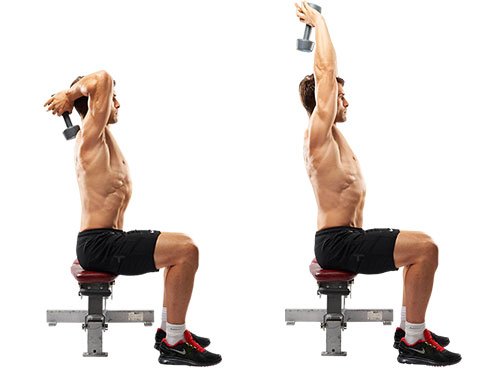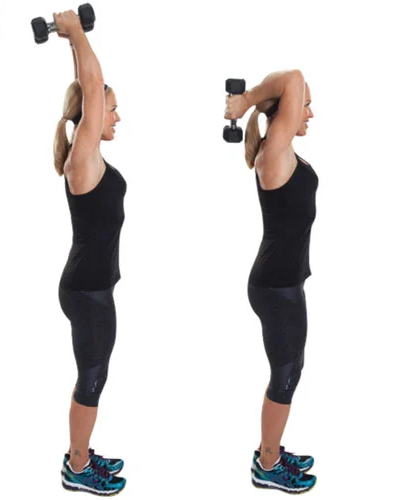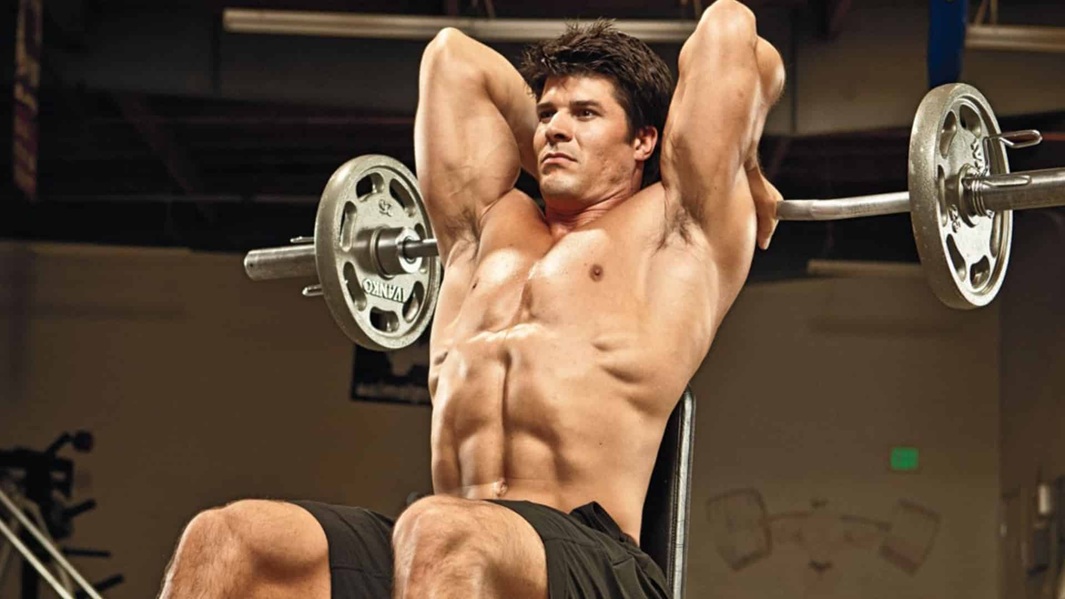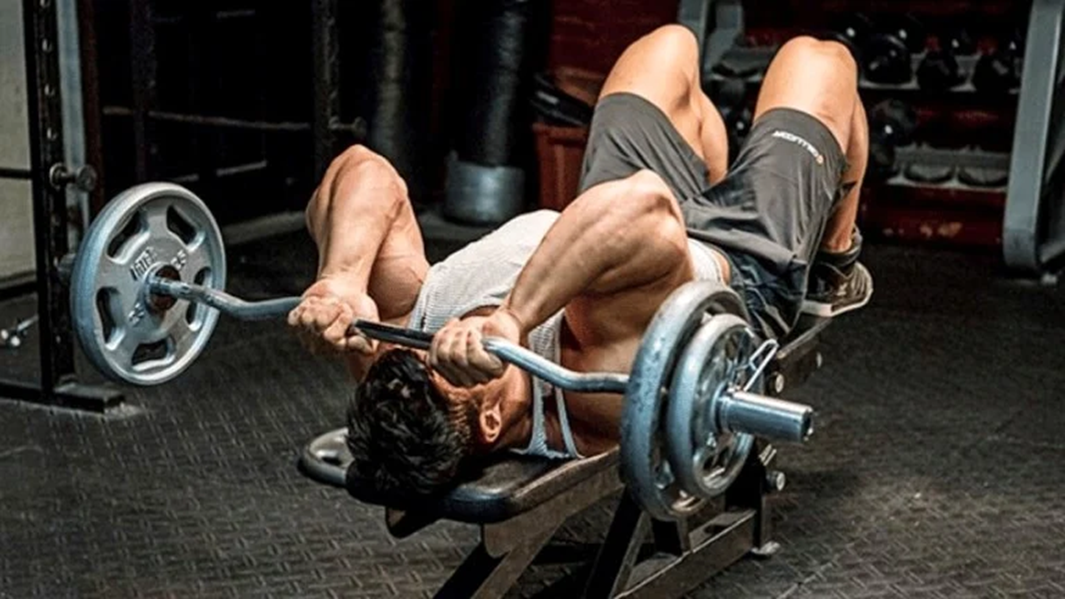Overhead Triceps Extension (Seated or Standing Dumbbell): Building the Long Head for Peak Arm Size
If you’ve ever admired a seasoned bodybuilder’s arms, you’ve probably noticed a distinct “hang” — that thick, meaty portion of the triceps that rounds out the back of the upper arm and makes the biceps look even more impressive. That’s the long head of the triceps, and one of the best exercises to target it directly is the Overhead Triceps Extension.
Whether performed seated or standing, with one dumbbell or two, this movement is a cornerstone in arm development.
It not only stretches the triceps through a full range of motion but also forces the muscle to contract hard from an extended position — a combination known to drive hypertrophy like few other triceps exercises can.
While compound movements such as close-grip bench presses or dips build pressing strength, the overhead extension is about shaping, lengthening, and maximizing the long head’s contribution to arm fullness. It’s a bodybuilding essential — one that builds both visual density and structural balance.
Let’s break down the anatomy, execution, variations, programming, and pro-level techniques to make the Overhead Triceps Extension one of your most productive tools for triceps growth.
Muscles Worked
Primary:
- Triceps brachii — emphasis on the long head
Secondary:
- Medial and lateral triceps heads (assistants during extension)
- Core (stabilization during standing version)
- Shoulders and forearms (stabilization)
👉 The long head of the triceps crosses both the shoulder and elbow joints. Any movement that involves elbow extension while the arm is overhead directly challenges it through an extended stretch position, stimulating deep muscle fiber recruitment and growth.
Why Bodybuilders Rely on the Overhead Extension
- Unmatched Long-Head Stretch
- Few exercises load the triceps so deeply in the stretched position — ideal for triggering hypertrophy.
- Isolation After Heavy Pressing
- Perfect follow-up after compound pressing to exhaust the long head and achieve a full pump.
- Improves Aesthetic Arm Balance
- Builds that lower-triceps “drop” that completes the arm’s horseshoe appearance.
- Shoulder-Friendly Alternative
- Compared to Skullcrushers, many lifters find this angle less stressful on elbows and wrists.
- Versatile and Accessible
- Requires minimal equipment — one dumbbell, a bench, or even a cable — and fits easily into any program.
Proper Form: Seated Overhead Dumbbell Extension
Setup
- Equipment
- Choose a moderately heavy dumbbell you can control through a full range of motion.
- Sit upright on a bench with back support.
- Grip & Positioning
- Hold the dumbbell with both hands under the inner plate, palms facing upward (diamond grip).
- Press the dumbbell overhead until arms are fully extended and elbows are close to your ears.
Execution
- Lowering Phase (Eccentric)
- Inhale deeply.
- Keeping upper arms stationary, bend your elbows to lower the dumbbell behind your head.
- Feel a deep stretch through the long head of the triceps as the dumbbell descends.
- Extension Phase (Concentric)
- Exhale as you extend the elbows, driving the dumbbell back overhead.
- Focus on using the triceps — not momentum or shoulder drive.
- Squeeze hard at the top for a full second.
- Repeat
- Maintain a slow, controlled rhythm with constant muscle tension.
Standing Variation
- The standing overhead extension increases the stabilization demand.
- Keep your core braced, glutes tight, and spine neutral.
- Excellent for those who prefer slightly more freedom of movement or don’t have a bench available.
Key Form Cues
✅ Keep elbows pointing forward — don’t let them flare out excessively.
✅ Lower the dumbbell slowly — the stretch is where the muscle grows.
✅ Don’t arch your lower back; engage the core.
✅ Maintain steady breathing and control at all times.
✅ Pause briefly at the bottom for an extra loaded stretch before extending.
Common Mistakes and Fixes
| Mistake | Issue | Solution |
| Elbows flaring too wide | Reduces long-head engagement, strains shoulders. | Keep elbows tucked near ears. |
| Excessive back arching | Overloads lumbar spine. | Brace core; keep ribs down. |
| Incomplete range of motion | Misses full long-head stretch. | Lower dumbbell fully behind head. |
| Using momentum | Reduces triceps tension. | Slow down — control both phases. |
| Too heavy a dumbbell | Forces shoulder and chest involvement. | Choose moderate weight, prioritize form. |
Dumbbell vs Cable vs EZ-Bar
- Dumbbell: Best for free movement and full stretch. Ideal for building mind-muscle connection.
- Cable: Keeps constant tension throughout — great for isolation and joint comfort.
- EZ-Bar: Allows heavier loads, excellent for advanced lifters focusing on mass.
Each tool can play a role in different phases of your training.
Variations
- Single-Arm Dumbbell Overhead Extension
- Greater focus on unilateral strength and correction of imbalances.
- Cable Overhead Extension (Rope Attachment)
- Delivers constant tension; great for controlled hypertrophy work.
- EZ-Bar Seated Overhead Extension (French Press)
- Allows heavier loading and stable two-hand grip.
- Kneeling Overhead Rope Extension
- Hybrid between cable and dumbbell style — isolates the triceps with minimal core interference.
- Machine Overhead Extension
- Ideal for lifters managing elbow discomfort; fixed motion pattern reduces stabilization demands.
Programming Guidelines
For Hypertrophy (Muscle Growth)
- Sets: 3–4
- Reps: 10–15
- Rest: 60–90 seconds
- Tempo: 3 seconds down, 1 second up
- Focus: Deep stretch, full contraction, minimal momentum.
For Strength and Density
- Sets: 4
- Reps: 6–8
- Rest: 2 minutes
- Focus: Heavier dumbbell, controlled negatives.
For Endurance and Pump
- Sets: 3
- Reps: 15–20
- Rest: 45 seconds
- Focus: High volume and constant tension.
Integration into Training
Example Arm Day
- Close-Grip Bench Press – 4×8
- Overhead Dumbbell Extension – 3×12
- Rope Pushdown – 3×15
- Skullcrusher – 3×10
- Barbell Curl – 3×10
Example Push Day
- Bench Press – 4×6
- Overhead Press – 3×8
- Incline Dumbbell Press – 3×10
- Overhead Triceps Extension – 3×12–15
- Lateral Raise – 3×15
Triceps Finisher
- Overhead Extension – 15 reps
- Rope Pushdown – 15 reps
- (Perform as a superset for maximum pump.)
Advanced Training Strategies
- Stretch Pause Technique
- Pause for 2 seconds at the bottom of each rep to maximize the long-head stretch.
- Rest-Pause Set
- Hit failure at 12–15 reps, rest 10–15 seconds, then continue for 3–5 more reps.
- Mechanical Drop Set
- Perform dumbbell overhead extensions → switch immediately to rope pushdowns for full burnout.
- Slow Eccentrics
- Lower over 4–5 seconds to enhance muscle fiber damage and growth signaling.
- Partial Reps at End of Set
- After full ROM failure, add 3–5 half reps from the bottom stretch zone.
Bodybuilder’s Tips
💡 Warm Up First: Light cable pushdowns or arm circles before loading the long head heavily.
💡 Don’t Rush the Stretch: The bottom portion is where growth happens.
💡 Choose Dumbbells Over Barbells for Comfort: The neutral grip is kinder on elbows.
💡 Keep Upper Arms Vertical: The more they drift, the less isolated the triceps become.
💡 Alternate Seated and Standing Variations: Prevents adaptation and balances core engagement.
Strength vs Aesthetics
| Focus | Approach | Key Benefit |
| Strength | Lower reps (6–8), heavier load, standing or EZ-bar version | Builds power and press lockout capability |
| Aesthetics | Moderate weight, higher reps (10–15), deep stretch, strict control | Carves long head for arm fullness and shape |
| Hybrid | Combine heavy sets + pump finishers | Blends density and definition |
Safety and Joint Health
- Warm up elbows and shoulders with light pushdowns or banded extensions.
- Avoid excessive arching during standing variations.
- Don’t force the stretch — gradual depth progression builds resilience.
- Use joint-friendly tools (EZ-bar, rope) if you have elbow sensitivity.
- Finish sessions with light stretching or band pull-aparts for recovery.
Practical Takeaways
✅ Prioritize form and control over load — especially at the bottom of the movement.
✅ Focus on deep stretch and full contraction to maximize long-head development.
✅ Alternate between dumbbell and cable versions for complete triceps growth.
✅ Pair with compound presses for both strength and shape.
✅ Keep the core tight to protect your lower back during standing versions.
Conclusion
The Overhead Triceps Extension isn’t just another arm accessory — it’s a cornerstone of long-head development and arm balance.
For bodybuilders, it’s the secret to creating that massive, flowing triceps sweep that makes the upper arm look full from every angle.
When done right, it delivers a perfect combination of stretch overload, isolation, and aesthetic shaping.
Rotate between seated, standing, and cable variations to continually challenge the muscle and unlock new growth potential.
Train it consistently. Control every rep. Stretch, squeeze, and repeat. Do that, and the Overhead Extension will reward you with dense, powerful triceps that complete your physique — the kind that looks as strong as it feels.




